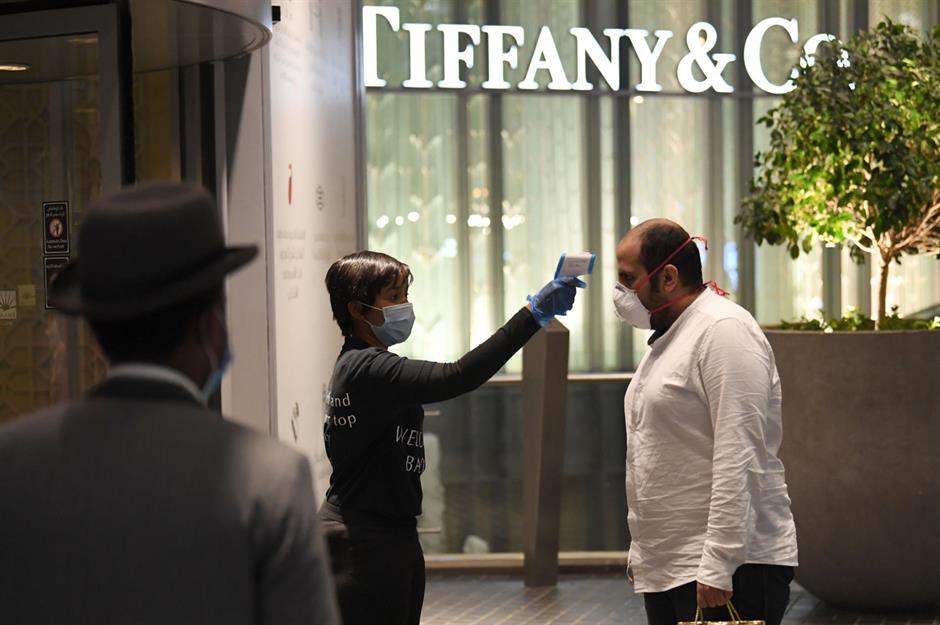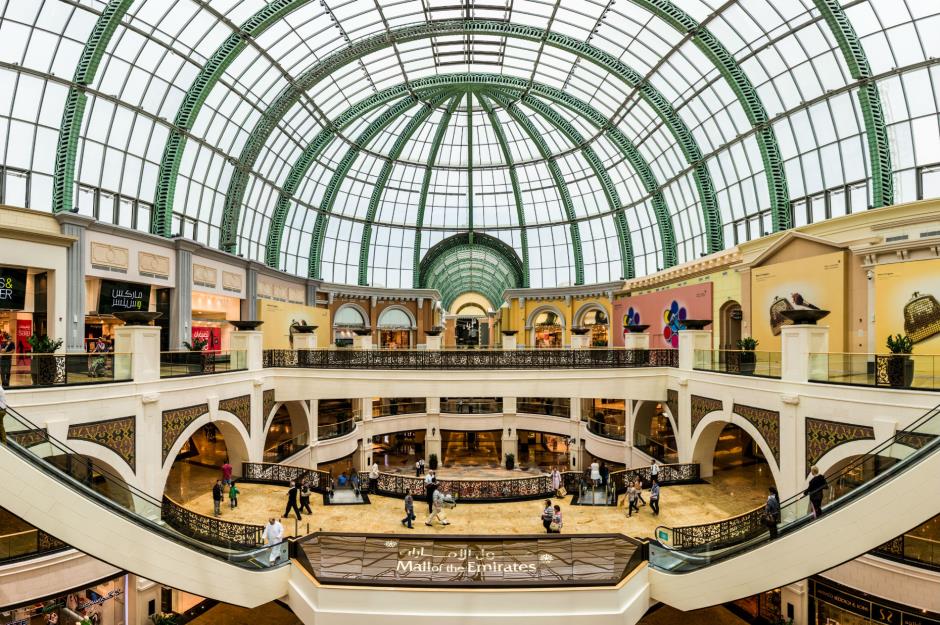The world's biggest shopping malls before and during coronavirus
The impact of coronavirus on the world’s most incredible malls
Before: The Mall of the Emirates, Dubai
Mall of the Emirates in Dubai was the world's first ever shopping resort, costing over 800 million Emirati Dirham, which was equivalent to $218 million at the time. The multi-level complex features around 630 international brands across more than 250,000 square feet (233,467 square metres) of shopping space. The mall is packed full of luxury goods with over 80 of the world's most renowned designed brands housed in the Luxury Wing.
Before: The Mall of the Emirates, Dubai
Now: The Mall of the Emirates, Dubai
Now: The Mall of the Emirates, Dubai
During the month of Ramadan (23/24 April to 23/24 May), lockdown was loosened and shops and businesses were allowed to return at 30% capacity, although demand has been slow and many businesses are still making layoffs. The Mall's cinema is still closed, but it has started running a pandemic-friendly drive-in cinema (pictured) since early May.
Now read about the drive-thru COVID-19 revolution
Before: The Ala Moana Shopping Centre, Honolulu, Hawaii
This shopping mall in Hawaii makes the most of the state's good weather, and is the largest open-air mall in the world. Built in 1959 on former swampland, the Ala Moana Shopping Centre has done well to hold onto this title. The mall also boasts one of the world’s largest food courts. The Makai Market food court was built in 1987, 28 years after the centre first opened.
Before: The Ala Moana Shopping Centre, Honolulu, Hawaii
Now: The Ala Moana Shopping Centre, Honolulu, Hawaii
Visitor numbers started to dwindle mid-March as the fear of coronavirus took hold, causing the mall to reduce its opening hours. It officially shut its doors on 23 March, meaning that deserted scenes like this became the norm. However, restaurants offering takeout and delivery, as well as healthcare services, grocery stores and banks with exterior entrances in the centre were allowed to remain open. The mall reopened on 15 May, from 11am to 7pm during the week and 12pm to 6pm at weekends, with measures such as hand sanitising stations and social distancing directions. But it will be some time before visitor numbers reach pre-pandemic levels. According to a survey of Hawaii businesses, 76% of jobs in the retail sector were lost between January and April.
Before: Siam Paragon, Bangkok
Before: Siam Paragon, Bangkok
Now: Siam Paragon, Bangkok
Now: Siam Paragon, Bangkok
Before: Mall of America, Minnesota, USA
Behold, the largest mall in the United States: the Mall of America. The super-complex is home to more than 520 stores, staffed by 11,000 employees year-round, hosting more than 42 million visitors annually. Among its attractions are a supersized LEGO Store, indoor roller coasters at Nickelodeon Universe – the largest indoor theme park in the United States – as well as fish-spotting at Sea Life Minnesota Aquarium and virtual tours of the United States at Fly Over America.
Before: Mall of America, Minnesota, USA
Now: Mall of America, Minnesota, USA
Or at least it did, until coronavirus hit. Deserted scenes like this suddenly became commonplace as the majority of stores were forced to close when Minnesota declared a state of emergency on 13 March. The mall reopened on 10 June – later than planned – due to nationwide civil unrest in the wake of the killing of George Floyd by police in Minneapolis, Minnesota.
Now: Mall of America, Minnesota, USA
Just 150 out of a total 500 stores opened their doors, leaving some shoppers disappointed to find that their favourite store was shut. According to Jill Renslow, senior vice president of business development, speaking to the StarTribune: "Parking spaces have been reduced by 50% [which] should keep the number of mall visitors at about 35% capacity". The mall usually has 150,000 visitors a day, which would mean around 52,500 visitors a day would be the maximum capacity right now.
Before: Trafford Centre, Manchester, England
This shopping centre is the second largest in the UK by retail size with 280 shops and services for customers to enjoy. While brands and labels vary, some of the more popular stores are the department stores Selfridges and John Lewis. Yet it's the architecture that gives this mall its wow factor. The Dome (pictured) cost $6.1 million (£5m) for a start. And there are lots of Venetian marble beauties for you to have a look at too.
Before: Trafford Centre, Manchester, England
The themed food court called the Orient is the largest in the UK, with a design that incorporates styles from around the world including New Orleans, China, Egypt, Italy, America and Morocco. The centre took 27 months to build and cost £600 million in 1998. That's the equivalent of £1 billion ($1.2bn) in today's money. In 2011 the site was sold for £1.65 billion ($2bn), which is the largest single property acquisition in British history. The centre welcomes 30 million visitors every year.
Now: Trafford Centre, Manchester, England
It's an entirely different story today, though. Pictured here in March, the Trafford Centre lacks its usual hustle and bustle and appears eerily empty. It was ordered to close on 23 March when the UK went into lockdown, although non-essential shops were able to open from 15 June.
Now: Trafford Centre, Manchester, England
Things have gone from bad to worse. On 26 June, the Trafford Centre's owner and landlord Intu collapsed into administration. Intu had previously suggested it was requesting an 18-month standstill agreement on its £4.5 billion ($5.5bn) debts, but could not persuade lenders in time. With the UK's economy now in recession, it's unclear what the impact will be on retail more generally, and so the fate of many shopping centres such as the Trafford Centre hangs in the balance.
Before: Grand Canal Shoppes, Las Vegas, USA
Built inside The Venetian Hotel & Casino and The Palazzo in 1999, this Las Vegas Strip shopping mall experience offers a once-in-a-lifetime shopping experience. For those of you who haven’t been to the Grand Canal Shoppes before, there’s something a little different about how you’ll be travelling, as the mall comes complete with gondola rides.
Before: Grand Canal Shoppes, Las Vegas, USA
Now: Grand Canal Shoppes, Las Vegas, USA
As you can see here, visitors can now take a gondola ride once more, so long as they bring their face mask. However, the broader impact of coronavirus on the tourist-dependent state of Nevada could be far-reaching. With 18.4% of its GDP coming from tourism, and a further 40% coming from leisure and hospitality, a speedy recovery will be needed to bring the state's economy back to life.
Before: Westfield, Shepherds Bush, London
Since it opened almost 12 years ago, Westfield London has welcomed over 250 million visitors and generates around $1.2 billion (£1bn) in sales every year. And in 2018 it got even bigger. Costing $848 million (£600 million), the expansion has made the mall the largest retail centre in Europe. Opening six months ahead of schedule, it has increased the total footprint of the centre to 2.6 million square feet (252,000 square metres) of letting space.
Before: Westfield, Shepherds Bush, London
As part of the grand opening, department store giant John Lewis celebrated opening its 50th UK store. A dedicated new outdoor events space has also opened, with a focus on alfresco dining. The expansion also included KidZania, an indoor city play experience for children who take on real-life 'jobs'.
Now: Westfield, Shepherds Bush, London
Now: Westfield, Shepherds Bush, London
On the opening day visitors noted long queues, especially outside budget clothing store Primark, as well as Apple and Louis Vuitton. There were extra security staff across the shopping centre, as well as a security guard outside each store ensuring limits of the number of shoppers inside were adhered to. However, things are looking gloomy for the British high street, with many chains entering administration, and stores having to slash prices in an attempt to lure shoppers back.
Before: West Edmonton Mall, Alberta, Canada
It’s estimated it cost $1.2 billion to build the biggest shopping centre in North America in 1981, the equivalent of $3.4 billion (£2.8bn) in today's money. The size of 104 football fields, the Canadian shopping mall was actually the biggest in the world until 2004. Shopping might the last thing you’d want to be do here as this shopping mall is home to the world’s largest indoor amusement park – Galaxyland – which has more than 24 rides to enjoy.
Before: West Edmonton Mall, Alberta, Canada
Now: West Edmonton Mall, Alberta, Canada
Before: The Dubai Mall, Dubai
Opening in 2008, this mall is part of the $20 billion (£16bn) Downtown complex. And with 120 restaurants and 1,200 shops (70 are exclusively set aside for haute couture) this complex is more like a mid-sized city. Visitors can enjoy the 76,000-square-foot SEGA indoor theme park, or keep kids entertained at KidZania, which is part of the chain that is also present at the Westfield shopping mall in London.
Before: The Dubai Mall, Dubai
The mall also has Dubai’s largest Cineplex – Reel Cinemas – with 22 screens, and the Dubai Aquarium and Discovery Centre where visitors can see nearly 33,000 sea creatures. Named the top attraction in the city of Dubai by US News & World Report, The Dubai Mall unsurprisingly has a lot of visitors, drawing in 80 million visitors every year. That means that it takes the title of the most visited mall in the world.
Now: The Dubai Mall, Dubai
Now: The Dubai Mall, Dubai
At the end of April, the mall reopened with increased security and safety measures in place. This includes testing visitors' temperatures with a "temperature gun" on entry, which is hardly the usual customer service you'd expect from a luxury shopping centre.
Read more: Open for business, what the 'new normal' looks like now

